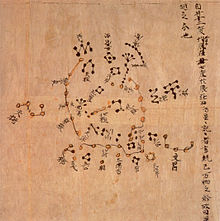
Astronomy in China has a long history stretching from the Shang dynasty, being refined over a period of more than 3,000 years. The ancient Chinese people have identified stars from 1300 BCE, as Chinese star names later categorized in the twenty-eight mansions have been found on oracle bones unearthed at Anyang, dating back to the mid-Shang dynasty. The core of the "mansion" (宿 xiù) system also took shape around this period, by the time of King Wu Ding (1250–1192 BCE).[1]
Detailed records of astronomical observations began during the Warring States period (fourth century BCE). They flourished during the Han period (202 BCE – 220 CE) and subsequent dynasties with the publication of star catalogues. Chinese astronomy was equatorial, centered on close observation of circumpolar stars, and was based on different principles from those in traditional Western astronomy, where heliacal risings and settings of zodiac constellations formed the basic ecliptic framework.[2] Joseph Needham has described the ancient Chinese as the most persistent and accurate observers of celestial phenomena anywhere in the world before the Islamic astronomers.[3]
Some elements of Indian astronomy reached China with the expansion of Buddhism after the Eastern Han dynasty (25–220 CE), but most incorporation of Indian astronomical thought occurred during the Tang dynasty (618–907 CE), when numerous Indian astronomers took up residence in the Chinese capital Chang'an, and Chinese scholars, such as the Tantric Buddhist monk and mathematician Yi Xing, mastered the Indian system. Islamic astronomers collaborated closely with their Chinese colleagues during the Yuan dynasty, and, after a period of relative decline during the Ming dynasty, astronomy was revitalized under the stimulus of Western cosmology and technology after the Jesuits established their missions. The telescope was introduced from Europe in the seventeenth century. In 1669, the Peking observatory was completely redesigned and refitted under the direction of Ferdinand Verbiest. Today, China continues to be active in the field of astronomy, with many observatories and its own space program.